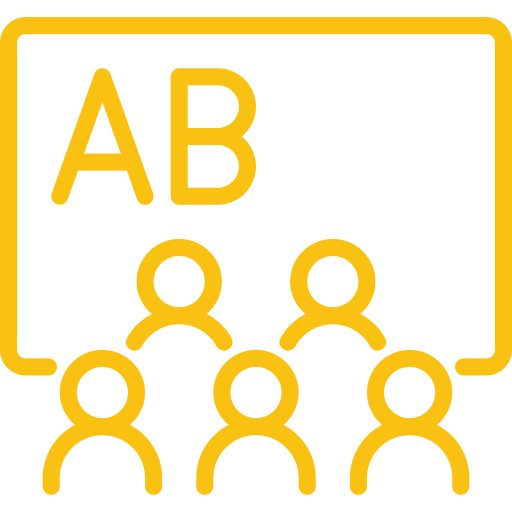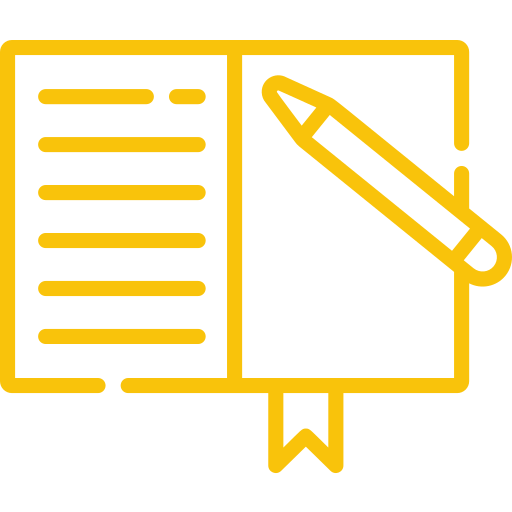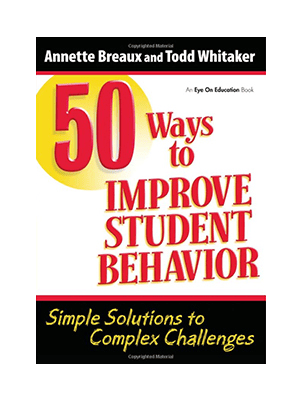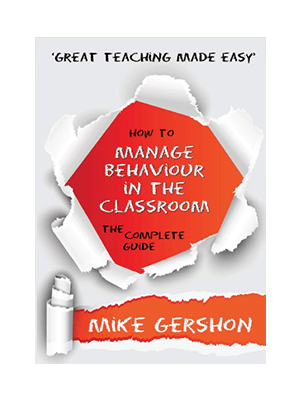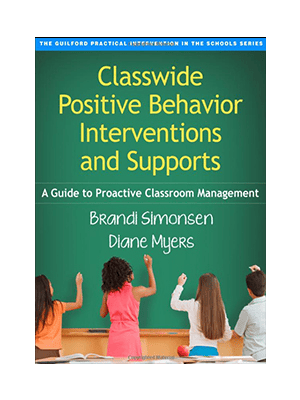Have you ever walked into a teacher’s classroom and noticed the walls are plastered with classroom rules? Class rules that cover everything that could possibly happen.
Especially new teachers, they often think they need a plan for every situation so that their rules can be consistent and cover all the problem behaviors that show up.
When it comes to managing a classroom, teachers often think of setting rules as a primary means of establishing order.
However, there is a subtle yet powerful shift that occurs when we transition from using the term ‘rules’ to ‘expectations’. This linguistic evolution can dramatically transform the atmosphere and behavior within a classroom, setting a more positive and collaborative learning environment.
I know, because that’s how I’ve been teaching my high school students for over 24 years.
Why Expectations Are Better Than Rules
“Rules and consequences imply a desire to control. Expectations and growth plans connote positivity and a focus on the students.” – PJ Caposey
Regardless of your teaching level, from elementary school to high schoolers, there will always be those who struggle against authority. When you set rules, you become the authority automatically. You will then be in charge of deciding what has been done wrong and right, and it also puts you on a pedestal. You become the judge, jury, and all the other roles that come along with that.
Behavioral expectations are different. Here’s how they set up your class for more effective classroom management.
Fostering a Sense of Ownership
Instead of presenting students with a list of regulations they must follow, fostering expectations gives students a sense of ownership over their behaviors.
Expectations communicate to students what they should aim to achieve, giving them the responsibility to self-monitor their actions and progress.
In both my classroom and my sports teams, I talk a lot to my kids about control. We can’t control other people’s behaviors, so we have to control our own behaviors. With my last softball team, the idea was that we would never take a close pitch with 2 strikes. That puts control on the umpire rather than on ourselves.
So from the beginning of the year there were clear expectations, stop waiting for others to make decisions and own your actions.
The same applies to my classroom. At the beginning of the year we set class expectations, that they will spend their time trying to out-learn me rather than waiting for me to deliver all the content they’ll ever need. Because I won’t always be there to teach them, they need to learn how to develop specific behaviors to ensure they’ll continue to learn, work with others, and do all the other things that will help them take the next step in their lives.
Encouraging Proactive Rather Than Reactive Behavior
While rules often focus on what students should not do (don’t run, don’t interrupt, etc.), expectations encourage students to proactively exhibit positive behaviors. They create a more positive atmosphere by emphasizing desirable actions, rather than reacting to undesirable ones.
If you want shade, the best time to plant a tree was in the past, not right now. If you want student behavior that is appropriate for a school environment, you need to start building positive relationships at the beginning of the school year. This is the most effective way to create a positive environment.
In other words, don’t spend all of your day on instructional time. (Sorry to any administrators out there reading this right now, but it’s the truth). Life has more tests to pass than the one you give at the end of the year…
I don’t pretend to know everything about my students and their lives, but I honestly care to get to know them. There is a balance, but it’s always best to deal with things before they get too big and emotional.
Creating a Collaborative Learning Environment
Expectations can also foster a greater sense of community and collaboration in the classroom. Instead of an authoritarian approach where rules are dictated by the teacher, expectations can be collaboratively created with students, encouraging their participation and making them more invested in maintaining a productive learning environment.
This is not to say your students run the class. Everything can’t be free choice and independent work, or letting the students always determine what appropriate language is in all situations.
It’s about cultivating a space where each student feels valued, heard, and motivated to contribute.
This sense of communal responsibility and shared learning outcomes is best achieved when classroom expectations, rather than hard and fast rules, guide the behavior and interactions of students.
Creating a collaborative learning environment begins with involving students in the creation of these expectations. A truly collaborative classroom blurs the traditional lines between teachers and students, inviting students to partake in shaping their own learning experiences.
This means hosting open discussions about what is expected from everyone in the classroom and why. When students contribute to the formation of classroom expectations, they are more likely to feel a sense of ownership, commitment, and responsibility towards them. And you might be surprised, it’s not uncommon for my students to have different behavior expectations than I do, and they are often stricter than I am!
Furthermore, these expectations should emphasize cooperation and teamwork. Examples might include “We listen to each other’s ideas,” “We support each other in learning,” or “We respect everyone’s contributions.”
These types of expectations highlight the importance of every student’s input and foster an environment where learners actively work together.
Also keep in mind that students’ culture plays a role in what they deem appropriate classroom behavior. In some cultures, eye contact is a sign of respect, in others it’s defiance. If you aren’t aware of this and other ways different cultures show respect, it might be time for you to do a little learning yourself.
Finally, the expectations for a collaborative environment must be consistently reinforced and modeled. Teachers should make a point to highlight instances where collaboration is done well and provide constructive feedback when improvements can be made. By continually emphasizing the value of cooperation and collective effort, students internalize these expectations, paving the way for a truly collaborative learning environment.
Examples of Classroom Expectations
- Respect Others: This is a broad expectation that covers a wide range of behaviors. It encompasses everything from respecting personal space to being considerate when others are speaking.
- Take Responsibility for Learning: This expectation promotes autonomy and encourages students to take charge of their education. It includes behaviors such as completing assignments on time, asking for help when needed, and actively participating in class.
- Engage Positively: This encourages students to engage with class content, their peers, and the teacher in a positive manner. It could include raising hands before speaking, listening attentively to others, and providing constructive feedback. It does not mean they have to be in a positive mindset all the time though. Students have other emotions, it’s not healthy for students to only experience life through one lens.
- Create a Safe Learning Environment: This expectation prioritizes the safety and well-being of everyone in the classroom. It covers both physical safety—such as using equipment properly—and emotional safety, like being kind and supportive to each other.
- Be Prepared: This expectation encourages students to come to class ready to learn, with all necessary materials and a mindset prepared for the day’s lessons.
- Stay Engaged: This can include behaviors such as maintaining eye contact, actively participating in class discussions, and staying on task during work time.
- Show Integrity: This expectation promotes honesty and ethical behavior, such as doing one’s own work and acknowledging sources when conducting research.
- Use Time Wisely: This expectation could be applied to working efficiently in class, prioritizing tasks effectively, and adhering to timelines for assignments.
- Celebrate Diversity: This expectation encourages students to value and respect the diverse backgrounds, experiences, and perspectives of their classmates.
- Problem-solve Collaboratively: This expectation urges students to work together to solve problems, helping them develop teamwork and negotiation skills.
- Practice Empathy: This expectation asks students to understand and respect the feelings of others. It can be reinforced through group work, discussions, and conflict resolution sessions.
- Express Gratitude: Encouraging students to express gratitude for help or kind gestures they receive promotes a positive classroom culture.
- Persist Through Challenges: This expectation teaches students about resilience, encouraging them to keep trying and not give up when faced with difficulties in their learning.
- Respect Class Time: This expectation covers behaviors like being punctual, minimizing disruptions, and focusing on the task at hand during class time.
Implementing Expectations in the Classroom
So how the heck do you take all this into account and implement it? How does it actually work in the context of the classroom?
Let’s take a look at a few ideas. (Every class has different experiences by the way, so I’m not expecting every class to be the same. There are lots of ways to do this, but here’s a starting point for you).
Open Discussion
When you first introduce these expectations, host an open discussion where students can voice their opinions and feel involved in the process. This encourages buy-in from the students, making them more likely to adhere to the expectations they helped create.
Consistent Reinforcement
Consistency is key. Frequently revisit your classroom expectations, reinforce them, and discuss examples of these expectations being met. This will remind students of the behaviors they’re striving for.
Positive Reinforcement
When you notice a student meeting or exceeding an expectation, acknowledge it. Positive reinforcement strengthens desirable behavior, making it more likely to happen again in the future.
Just be careful not to overdo the behavior-specific praise, if it’s always directed at the same students and it happens all the time you end up losing the positive influence you wanted on the other students.
Just like with your assignments, there will always be students who are good at the game of school, and will use this as a measuring stick (just like grades) to separate themselves from everyone else).
Visible Reminders
Once you have established the expectations, make them visible in the classroom. You can put up posters, make a bulletin board display, or even include them in students’ notebooks or planners.
This constant reminder helps students internalize the expectations.
Incorporate in Lesson Plans
Try to integrate the expectations into your daily lesson plans. For example, if one of your expectations is ‘Respect Others’, design activities that necessitate mutual respect. This shows students that expectations are not arbitrary, but integral to the learning process.
Use Role-Playing Exercises
Role-play scenarios can be an effective way for students to understand and apply expectations.
Create scenarios where students have to apply expectations, then debrief about how the expectations guided their behavior and how they can apply them in real situations.
Student-Led Discussions
Regularly schedule student-led discussions about classroom expectations. Encourage students to share examples of when they or their peers met an expectation, and discuss ways to handle situations when expectations are not met.
Reflection Activities
Allow students to reflect on their behavior in relation to the expectations. This could be through journaling, one-on-one conferences, or class discussions. Reflection helps students to self-assess their behavior and think about ways to improve.
Implement a Positive Behavior Support System
A system that rewards students for meeting expectations can be very effective. Rewards could be verbal praise, earning points towards a class reward, or even simple tokens or stickers. Be sure to focus on recognizing effort and improvement, not just perfection.
Parent Communication
Make sure parents or guardians are aware of the classroom expectations. This can be done through a letter home, during parent-teacher conferences, or through a class website or newsletter. When parents know the expectations, they can support their children in meeting them at home.
Addressing Expectation Violations
Despite our best efforts, there will inevitably be times when expectations are not met. How we handle these situations is critical.
Open Communication
If a student violates an expectation, it’s crucial to communicate openly with them. Discuss why the behavior is inappropriate and how it affects the learning environment. Help them understand how they can make better choices in the future.
Solutions-oriented Approach
Instead of focusing on punishments, encourage students to come up with solutions that rectify their behavior. This empowers them to take responsibility for their actions and promotes problem-solving skills.
Restorative Justice
This approach emphasizes repairing the harm caused by the violation. For instance, if a student disrupts the class, they might apologize to the class or come up with a plan to avoid such disruptions in the future. This fosters empathy and responsibility.
Behavior Reflection Forms
These forms give students the opportunity to reflect on their behavior when they’ve violated an expectation. They can identify what expectation they didn’t meet, why they didn’t meet it, and how they plan to improve in the future.
Student-Teacher Conference
When an expectation violation occurs, schedule a one-on-one meeting with the student. Discuss the violation, why it is problematic, and what can be done differently next time. This personal approach can be very effective.
Teachable Moments
Use the violation as a teachable moment for the entire class. Without singling out the student, discuss the importance of the expectation that was violated and how it contributes to a positive learning environment.
Parent-Teacher Collaboration
If a student frequently violates expectations, involve parents or guardians. Discuss the issue with them, seek their input, and work together to develop a plan to help the student meet the expectations.
Mentorship or Buddy System
Pair students who frequently violate expectations with a mentor or buddy who consistently meets expectations. This peer influence can often help guide behavior.
Detention or Time-Out
If the violation is severe or persistent, consider using detention or time-out.
This should be coupled with a discussion about why the behavior is inappropriate and an opportunity for the student to reflect on their behavior.
Be careful with this one. I personally have a time-out room when the behavior is bad enough that they need some time away, but not so bad that they need a referral.
My room is next door between 2 teachers’ classrooms, so they are still supervised.
Behavior Contracts
For recurring behavior issues, consider developing a behavior contract with the student. Outline what behavior needs to change, what steps the student will take to meet the expectation, and what the teacher will do to support them.
Final Thoughts
To summarize, establishing clear, positive expectations, rather than punitive rules, can create a classroom atmosphere that is conducive to learning, engagement, and mutual respect.
As a teacher, it’s crucial to consistently reinforce these expectations, communicate openly, and encourage students to take ownership of their behavior.
With these strategies, we can cultivate a classroom environment that fosters academic growth and personal development.
How We Can Help
It’s what we do here at MTI. We help teachers improve their craft while also increasing their salaries.
If you’re looking for courses on classroom management, check us out by clicking here.
And if you know anyone who could benefit from these resources, please pass it along. We’re all in this together, and we all benefit from sharing.
It’s why MTI has always been “teachers helping teachers.”
